If you love books, you’ll love book-tracking apps. Goodreads has dominated this digital sphere for a long time, but StoryGraph is quickly becoming an attractive Goodreads alternative for busy readers who want to track their reading habits more effectively.
StoryGraph vs. Goodreads, which do you prefer? In this article, we’ll compare these reading trackers based on their features, user interface, customization, recommendations, and reviews.
goodreads vs. storygraph: features
Goodreads
Goodreads is the standard for people who want to catalog their reading habits. It launched in December 2006 and has enjoyed a strong fanbase ever since. Now, Goodreads has more than 150 million members, making it the largest community of readers in the world. It is available online or via the App Store and Google Play Store.
Here are some of Goodreads’ features.
- Amazon book purchases
- Bookshelves
- Buddy reads
- Current reading lists
- Want-to-read lists
- Ratings
- Reading challenges
- Reading stats
- Lists
- Kindle notes & highlights
- Widgets
- Polls
- Q&As
Lists, which are part of the ever-expanding world of Listopia, are one of the most popular features. They allow users to discover niche genres, interests, and writers. Users vote on the books, which are ranked accordingly.
Lists such as “Best Gothic Books of All Time” and “Best Books Of the Decade: 2020” have over 3,500 votes, so you’re sure to get a realistic insight into what your fellow book lovers like to read. You can also browse through more niche lists, including “YA Books Inspired by Non-Western/Eastern Mythology” and “Books Related to an Element in the Periodic Table.”
Whether you’re a lone literary lover or someone who wants to build a community of like-minded individuals, Goodreads has all the features you need.

StoryGraph
CEO Nadia Odunayo launched StoryGraph in 2019. By December 2023, there were over two million registered users, positioning this small but impressive company as an increasingly appealing alternative to Goodreads.
The platform boasts 10 million book reviews each day and 36 million page views per month. Like Goodreads, StoryGraph is available online or via the App Store and Google Play Store.
StoryGraph takes a different approach to book-tracking. Instead of honing in on the community side of the literary world, it focuses more on individual reading habits. It is much more visual than Goodreads, incorporating all kinds of charts and graphs into your tracking tools.
Here are some of StoryGraph’s features.
- Buddy reads
- Graphs
- Moods
- Insightful stats
- Personalized recommendations
- Simple tracking
Like Goodreads, StoryGraph has a standout feature that separates it from other book-tracking apps. On StoryGraph, books are categorized by moods. This alternative ranking system can be contentious, but plenty of people love it. Moods include adventurous, challenging, dark, emotional, funny, hopeful, informative, inspiring, lighthearted, mysterious, reflective, relaxing, sad, and tense.
If you want a streamlined yet still personalized approach to book-tracking, StoryGraph could be perfect for you.
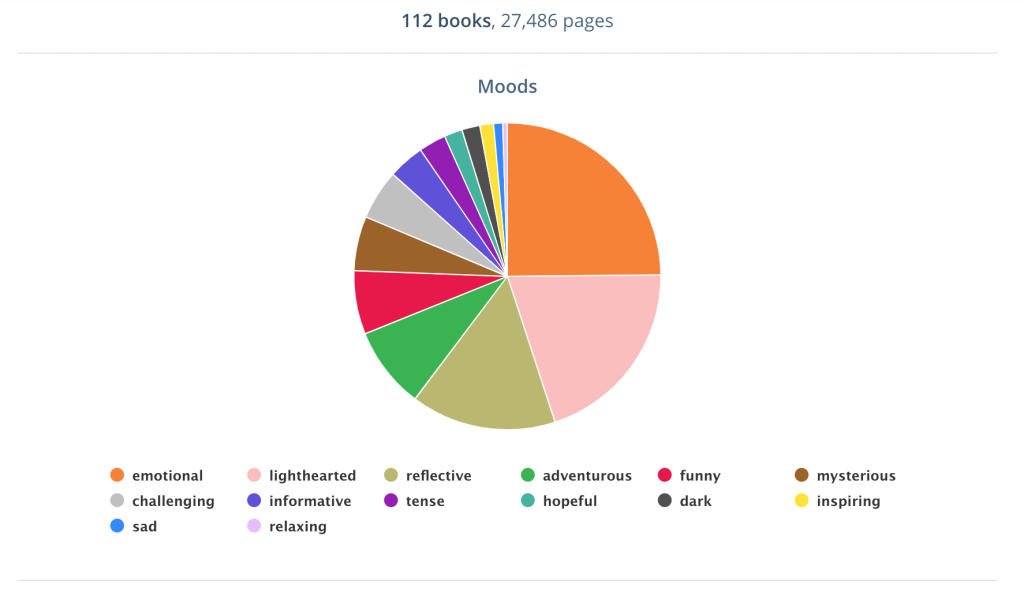
storygraph vs. goodreads: user interface
Goodreads
It’s clear that both these reading tracker apps prioritize personalization. As soon as you log in, you’ll see a short, mostly empty home page that invites you to customize your experience. The menu at the top of the page gives you access to other sections, including My Books, Browse, and Community.
All the pages are relatively intuitive. However, it might take some time to acclimatize to the vast number of options available; there are so many challenges, reading lists, and discussions that Goodreads can seem overwhelming.

Goodreads + Amazon Integration
Goodreads has cross-platform compatibility with Kindle and Amazon book purchases.
To sync to Amazon:
- For a new account, go to the signup page and select ‘Sign up with Amazon’
- For an existing account, go to My Books and select Add Amazon account
To sync with Kindle:
- Go to the Home page
- Tap the Menu button
- Tap Settings > My Account > Social Networks
- Select Goodreads
- Follow the directions on the screen
This feature promises a seamless reading experience across different devices and accounts. However, some readers aren’t aware that Amazon owns Goodreads, and may be eager to try a reading tracker owned by one of the smaller, independent players in the industry.
StoryGraph
StoryGraph users are greeted with a minimalist home page. One of the big differences between Goodreads and StoryGraph is that the latter is much more visual. Whereas Goodreads opts for small book covers, StoryGraph prefers big, clear visuals. According to researchers at MIT, the brain can process entire images in as little as 13 milliseconds, which explains why most people find visual information easier to grasp.
The menu at the top of the page gives users easy access to Stats, Reading Challenges, the Community, and Giveaways. All these pages are just as simple and visual as the home page, making navigation super easy.
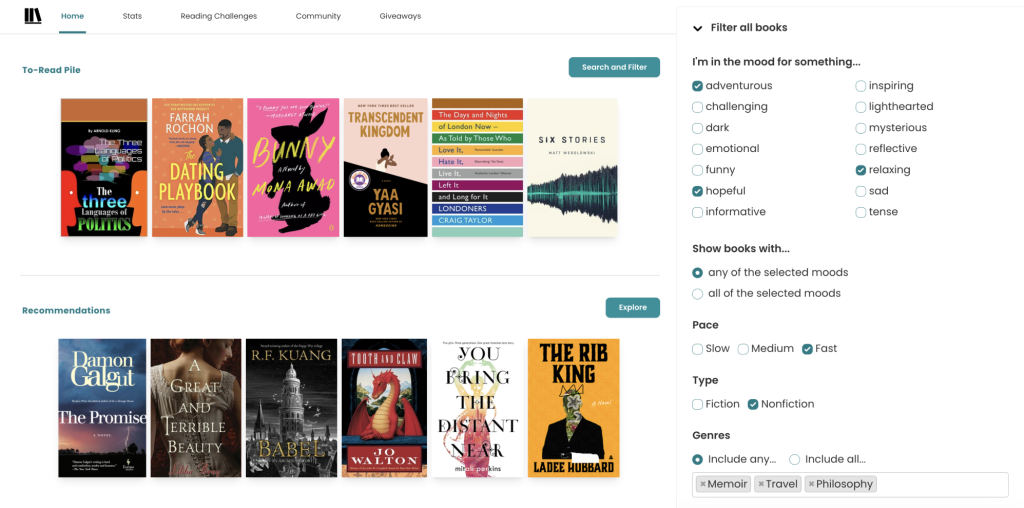
Winner: StoryGraph. This reading tracker favors visual elements, which reduces the learning curve and makes for a more intuitive user interface.
→ Not sure what to read next? We’ve compiled a list of 15 BookTok recommendations that are actually good.
goodreads vs. storygraph: customization
Goodreads
On Goodreads, the left-hand side includes updates on News and Interviews and your 2024 Reading Challenge. In the center of the page, you can find an empty Updates list, which acts as a feed for all your activities on Goodreads. Click the customize button next to updates to select what type of content you want to see.
Remember, Goodreads is a community-focused reading tracker, so there are plenty of customization options that are designed with that in mind. You can filter updates to include the general Goodreads community or keep your circle small with top friends only.
From there, there’s really no end to the personalization options at your disposal. Fill your bookshelves, create your own bookshelves for specific genres, feelings, and inclinations, give ratings, write reviews, and embed Goodreads widgets into your blog.
StoryGraph
StoryGraph doesn’t have as many customization options, but it offers a reasonable number of tools for readers who want to personalize their reading tracking. The home page has a section for your To-Read Pile, Recommendations, Giveaways, Current Reading, and Popular Books.
Winner: Goodreads. Customization is at the heart of Goodreads, allowing users to create a truly curated experience.
storygraph vs. goodreads: community
Goodreads
Goodreads’ community has five sections:
- Groups: Join groups to read and rave about books at the same time as your peers. There are all sorts of book clubs, including the ever-popular Oprah’s Book Club, Reese’s Book Club, and more general groups such as What’s the Name of That Book???
- Discussions: Either join existing discussions or start your own to gain insight into your favorite character, share recommendations, or simply chat about the literary sphere.
- Quotes: Browse through popular, recent, and new literary quotes to discover and save nuggets of wisdom from your favorite authors.
- Ask the Author: Ask your favorite author questions about characterization, plots, and any other literary question that’s on the tip of your tongue.
- People: Explore the most popular reviewers in your area and dive down a rabbit hole of recommendations.
If you use all of Goodreads’ features, you will soon feel like you’re part of a thriving literary community.
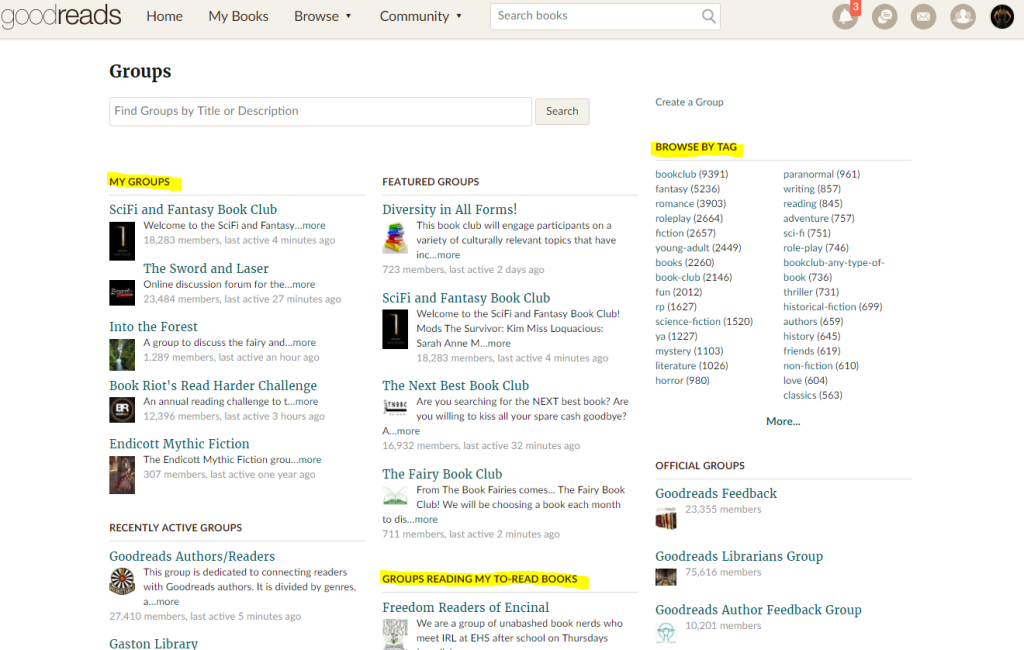
StoryGraph
StoryGraph also has a Community tab, but it’s more streamlined. To start with, there’s only one Community page, which feels less overwhelming.
The Community page features a drop-down tab that includes:
- News Feed: Customize the Feed to include friends or explore it to find new readers to follow.
- Buddy Reads: Sign up for existing Buddy Reads or make your own.
- Readalongs: Explore live Readalongs or create your own.
- Book Clubs: Create a new book club to connect with like-minded readers.
- Similar Users: Browse through similar readers or use the advanced search feature to filter by mood.

Winner: Goodreads. Goodreads fans can simply log on and, more often than not, find an existing community that fits their needs, whereas StoryGraph fans might have to take a more proactive approach.
goodreads vs. storygraph: reviews
Goodreads
Goodreads’ reviews follow a standard format that you would expect from a book review. You can include a star rating, a review of up to 15K words, bookshelves/tags, and the read date. There is even a feature that allows you to track rereads, as well as the option to post the review on your blog and/or personal feed.
Diligent readers can also add private notes, which are for their eyes only. All in all, Goodreads offers a comprehensive review experience, allowing users to write reviews that benefit the larger community.

StoryGraph
In contrast, StoryGraph trims away all the extras to get to the heart of your reviews. Reviewers are faced with a survey-style list of statements and questions that focus on the mood and pace of the book, as well as characterization, lovability, and plot points.
This is where StoryGraph’s signature mood feature comes into play. Select any number of moods from a choice of 14 moods and, after a few more reads, watch your own personal pie chart appear. From there, you can see which moods you gravitate toward.
Each review also has a freeform comment section that allows you to leave additional thoughts, but overall StoryGraph’s reviews are pretty standardized. For some, this efficient approach might be perfect. For others, it eliminates the satisfaction of writing a detailed review.

Winner: Goodreads. Although StoryGraph might work for some, Goodreads’ success speaks for itself. Most readers don’t want to be guided by preset questions, especially when they feel passionate about their latest read.
storygraph vs. goodreads: tracking tools
Goodreads
Sometimes, tracking your progress can be half the fun of reading. Luckily for Goodreads users, they have access to plenty of tracking tools. There are four preset Bookshelves, including All, Read, Currently Reading, and Want to Read. Goodreads also allows you to update books on your Current Reading list with page-by-page progress.
Here are some of Goodreads’ more advanced tracking tools.
- Reading Challenge: Set yourself a reading challenge and stay motivated by reading alongside friends and members of the community.
- Reading Stats: See your books, pages, publication year, books over time, and pages over time.
- Year in Books: Browse through a visual representation of your yearly reading habits, complete with interesting information about the shortest and longest books you’ve read, the most and least popular, and your average star rating.
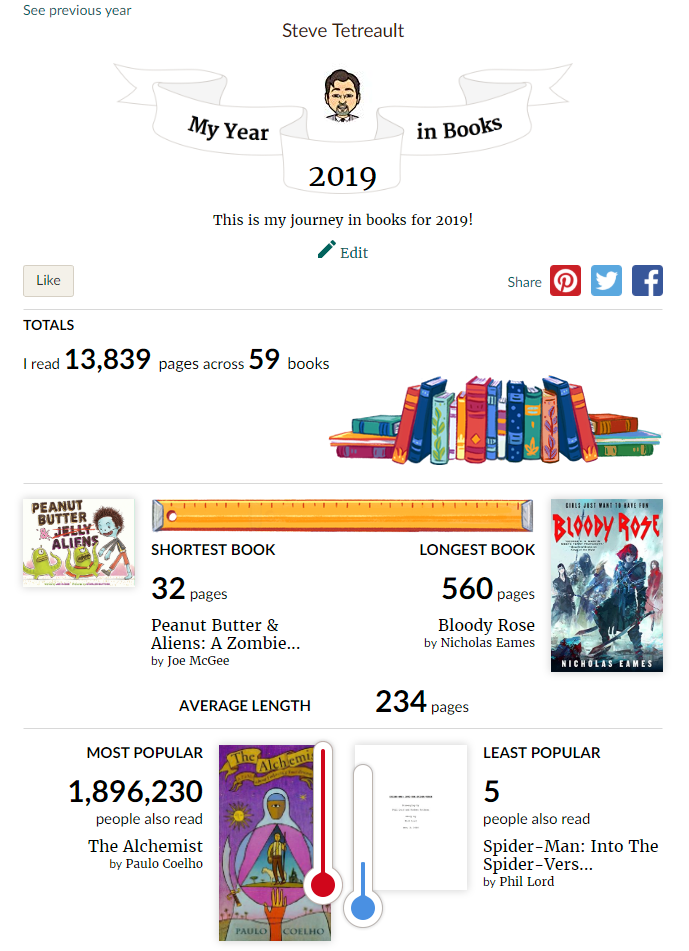
StoryGraph
Once you’ve started reading a book on StoryGraph, you can go back and make a note of the number of pages you’ve completed. On top of that, you can set reading, page, and hours goals to keep your reading habits on track.
On the Stats page, you’ll find a range of visual tracking tools. StoryGraph uses pie charts, bar graphs, and scatter plots to track your genre, format, language, and author preferences. The graphs are interactive, allowing you to hone in on specific aspects of your reading experience.
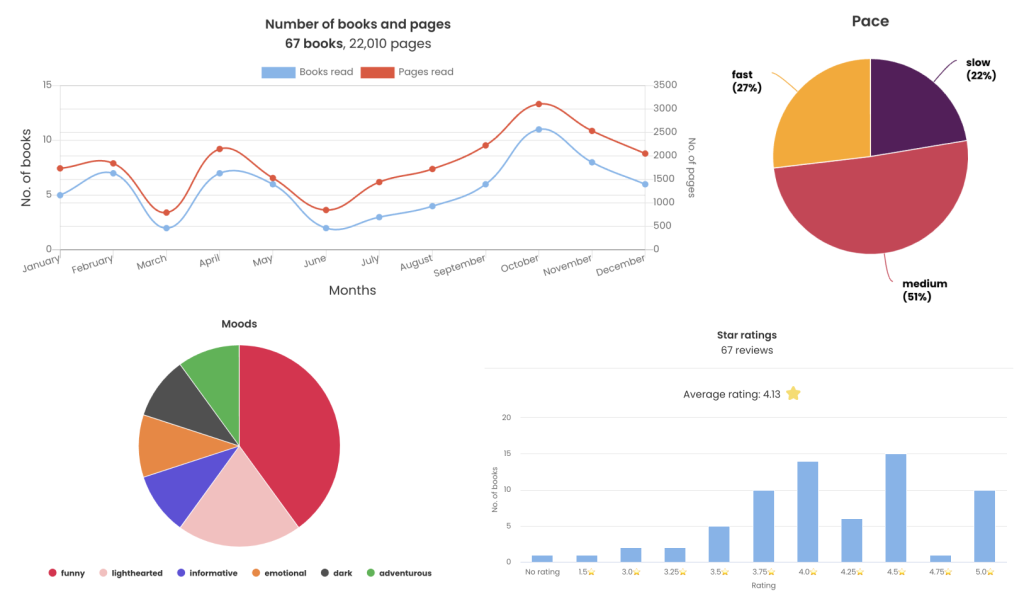
Winner: StoryGraph. StoryGraph cinches the win for its easily digestible, visual tracking tools.
→ Explore our 4 best read-it-later apps for iPhones to supercharge your reading potential.
storygraph vs goodreads: recommendations
Goodreads
Like any good book-tracking tool, Goodreads has a Recommendations tab. You need to rate at least 20 books to get recommendations, which can be disappointing for newbies. Then again, Listopia offers a whole range of extremely niche recommendations, so your next favorite read is only a few clicks away.
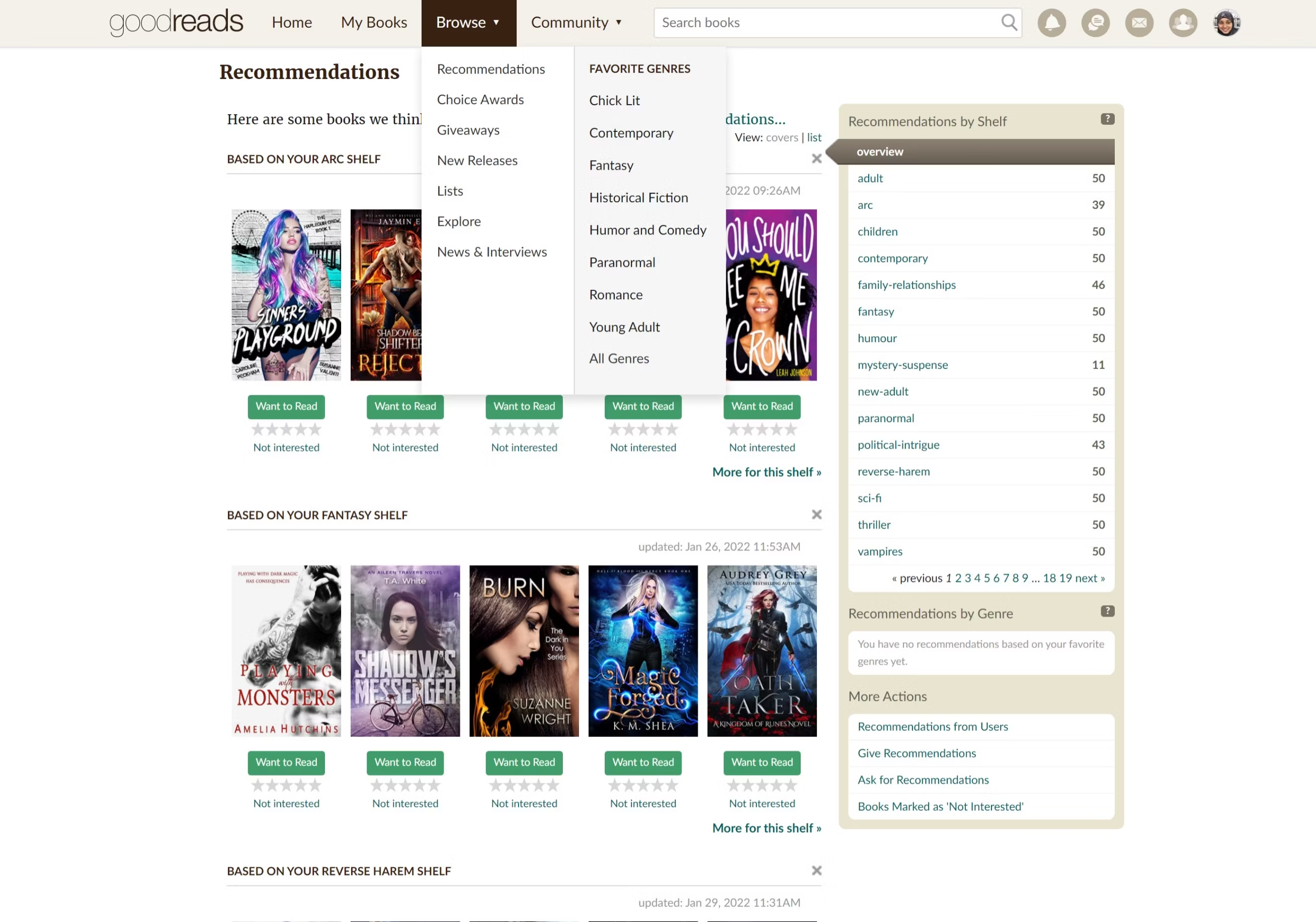
StoryGraph
StoryGraph also has a recommendations feature. Luckily, StoryGraph generates recommendations regardless of whether you’ve reviewed any books. Every new user has to complete a survey, and the data is transformed into recommendations. You can even use the Advanced Search feature to filter recommendations by mood.
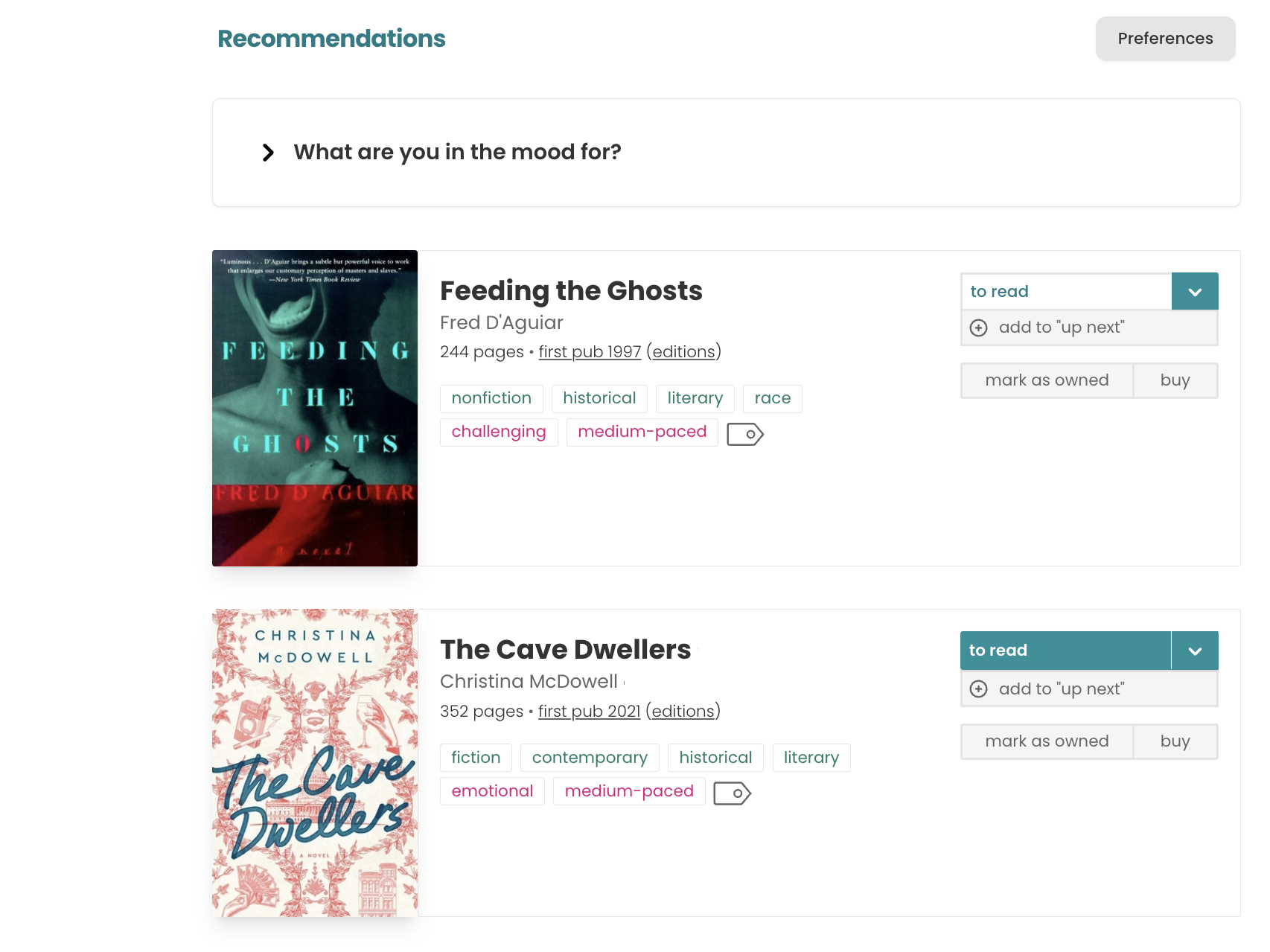
Winner: Draw. StoryGraph’s recommendations are more accessible, but that doesn’t necessarily mean they’re better. Goodreads’ recommendation tool requires 20 ratings, which might make your recommendations more personalized.
overall winner: goodreads
In the battle of Goodreads vs. StoryGraph, Goodreads is the overall winner. Goodreads has established itself as the go-to tracking tool for bibliophiles. When we look at the broad range of features, personalization, and customization options, it makes sense that millions of people prefer Goodreads.
That said, StoryGraph still has plenty of attractive features. The visual-first approach will appeal to many, as well as the streamlined review process.
Goodreads is a traditional reading tracker, whereas StoryGraph takes a more modern, innovative approach that appeals to busy readers who can only spare a few minutes to track their reading progress.
Ultimately, the choice is yours. Do you prefer community or individuality? In-depth reviews or short, concise reviews? StoryGraph vs. Goodreads, the choice is yours.
bookcase: turn your smartphone into an ergonomic e-reader

Between neck strain and hand cramps, reading on your phone can be uncomfortable. Built for iPhone and Android – Bookcase transforms any smartphone into an ergonomic e-reader by extending the area around the screen.
The edges of the case provide grips on both sides of your phone so you can hold it more comfortably and enjoy a clear view of your screen while reading.
Plus, Bookcase carries an embedded NFC tag for creating user shortcuts. With the companion app, you can tell Bookcase which of your favorite reading apps to open and which phone settings to toggle (Do Not Disturb, Reading Mode, etc.) when your phone is connected. The next time you place your phone into Bookcase, your settings will trigger automatically.
Bookcase helps you avoid doomscrolling and encourages you to build a more productive reading habit without buying an expensive e-reader or carrying around an extra paperback.




